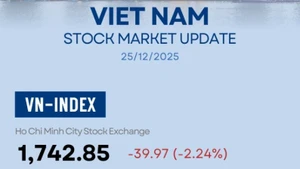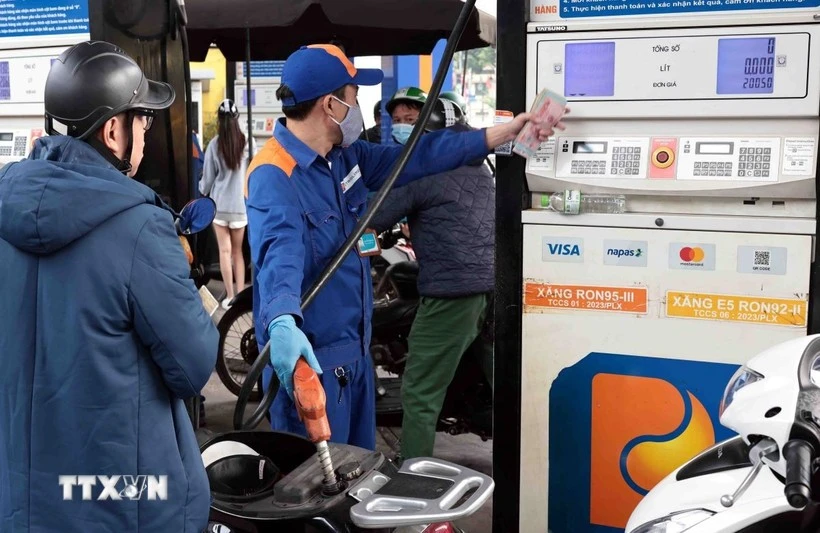On a weekend morning, Xuan Mai (Thanh Xuan Ward, Ha Noi) makes a cup of coffee and opens her phone, scrolling through products on e-commerce platforms as part of her daily routine. Online shopping not only helps her find what she needs, but also serves as a form of relaxation, a way to discover new products, and to hunt for bargains.
“I like browsing livestreams. It’s convenient to see how products are used, and I can place orders immediately. Sometimes I even get discounts and gifts.”
Impressive growth momentum
Similarly, when he wanted to buy a new table and chair set, Phan Tuan (Cau Giay, Ha Noi) watched a product livestream featuring detailed evaluations of materials, colours, and dimensions. He watched while reading comments from previous buyers for comparison.
“Livestreams help me see products clearly, understand how to use them, compare prices, and choose what suits me without having to visit multiple stores. After just a few clicks, both the table-and-chair set and the vacuum cleaner were ordered and will be delivered within a few days.”
The experiences of Mai and Tuan reflect a broader trend among Vietnamese consumers, who increasingly trust online shopping, from everyday essentials to large, high-value items, often relying on livestreams, product reviews, and comments from other shoppers to make decisions.
Recognising these trends, platforms such as TikTok Shop, Shopee, and Lazada have leveraged livestreaming and digital technologies to enhance customer experience, expand market share, and achieve impressive growth amid fierce competition. Specifically, platforms have produced livestreams and short videos demonstrating products, combined with user-review and commenting tools that help shoppers make decisions more easily.
At the same time, platforms apply artificial intelligence (AI) and big data to suggest suitable products, optimise advertising, and personalise promotions. Fast-payment systems, convenient delivery options, and integrated discount programmes and vouchers create favourable conditions for customers to place orders and receive products quickly.
With these strategies, in the third quarter of 2025, TikTok Shop recorded an outstanding growth rate of 69%, while Shopee and Lazada maintained their leading positions with stable transaction volumes. Sendo also posted a double-digit growth. These achievements helped the e-commerce market reach 103 trillion VND (equivalent to around 4.14 billion USD) in the third quarter of 2025, up 22.25% year-on-year.
Given these positive results, the Ministry of Industry and Trade has raised its forecast for e-commerce growth in 2025 to 25.5%, with total transaction value expected to reach 26–28 billion USD, reflecting an optimistic outlook for the remaining quarters and reaffirming e-commerce’s growing importance in the digital economy.
Prioritising consumer protection
Although the scale of Viet Nam’s e-commerce continues to expand, the number of sellers generating revenue has fallen by more than 7,000 compared to the same period last year. Nguyen Phuong Lam, Market Analysis Director at YouNet ECI, said this trend reflects a strong market filtering process, as consumers increasingly favour prestigious, professional sellers who make serious investments. Rising platform costs have also pushed many small, less professional sellers out of the market.
“Besides competing on price with established brands, businesses face pressure from the widespread presence of low-quality goods, making them more vulnerable. To break through, they need support with policy, infrastructure, and tools from the State.”
From the perspective of manufacturing enterprises, Nguyen Trung Dung, CEO of Dh Foods Joint Stock Company, said the company faces challenges in expanding e-commerce to international markets. As the company does not have warehouses in the US, all products must be shipped directly from Viet Nam, resulting in high logistics costs and difficulties in controlling delivery times, especially during peak seasons.
“We are researching new logistics models, including establishing transit warehouses in target markets or partnering with international logistics providers to reduce costs and enhance customer experience.”
From a management perspective, according to Lai Viet Anh, Deputy Head of the E-commerce and Digital Economy Agency under the Ministry of Industry and Trade, one of the biggest concerns for consumers when shopping online is the fear that products will not match their descriptions. Buyers also worry about receiving low-quality goods, counterfeit or imitation products, or items that differ from the images and descriptions displayed online.
Nguyen Phuong Lam, Market Analysis Director at YouNet ECI, forecasts that Viet Nam’s total e-commerce transaction value could reach 49.9 billion USD annually by 2028, if the industry fully leverages emerging growth opportunities. His optimistic outlook is based on rising household incomes, which will drive e-commerce spending over the next five years; the trend of shopping combined with entertainment; and the significant shift of high-value product categories from traditional channels to e-commerce.
This reality highlights the need for more comprehensive and appropriate solutions to build a transparent, safe business environment that protects the rights of consumers and prestigious enterprises.
For this reason, ahead of the year-end shopping peak, e-commerce platforms and Vietnamese enterprises are deploying strategic measures to improve service quality, optimise customer experience, and promote sustainable revenue growth. Notably, the Ministry of Industry and Trade has just launched the 2025 National E-commerce Week and Viet Nam Online Shopping Day (Online Friday) under the theme “Safety – Peace of Mind – Joy”, aimed at boosting market confidence, protecting consumers, and encouraging transparent, sustainable e-commerce development.
Accordingly, platforms such as TikTok Shop leverage livestreaming, short videos, and AI- and data-driven personalised recommendations to help consumers make quick decisions and increase shopping frequency, while supporting Vietnamese businesses in reaching millions of customers. Shopee improves user experience through interactive livestreams, combats counterfeit goods using machine-learning technology, and partners with logistics providers to shorten delivery times, boosting sales while strengthening brand credibility.
Alongside technological solutions and online events, the integration of fast delivery, convenient payment systems, vouchers, and personalised incentives facilitates seamless shopping and drives sustainable revenue. Platforms are also strengthening cooperation with multi-channel networks (MCNs), key opinion leader (KOLs), and technology partners, helping Vietnamese enterprises enhance competitiveness and expand domestic and international markets.
Nevertheless, to ensure product quality, the Ministry of Industry and Trade will work closely with major platforms and partner enterprises. All products featured in the event undergo strict verification, with priority given to Vietnamese goods, signature products from small and medium-sized enterprises, and Vietnamese agricultural products.
Consumers can submit feedback directly via hotline and receive prompt responses, while task forces supervise, evaluate, and conduct periodic reviews to ensure purchased products are genuine and aligned with commitments. For livestream-based promotions, sellers are strictly monitored to ensure truthful, manufacturer-based information, with ongoing supervision and assessment to protect consumer rights and business prestige.
















